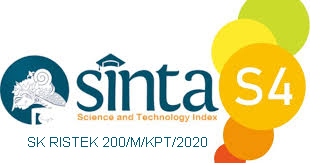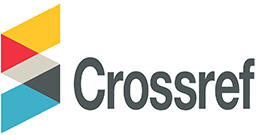The Classification of Mushroom Types Using Naïve Bayes and Principal Component Analysis
Abstract
Indonesia is one of tropical countries with high humidity which makes it possible for various plants and microorganisms to grow properly. One of the microorganisms that shall grow well in Indonesia is be considered as fungi or mushrooms. They have several types including poisonous and edible mushrooms that shall be consumed by human beings. The purpose of this research is to make it easier to classify between the types of poisonous mushrooms and edible mushrooms which can be consumed by using the Naïve Bayes algorithm to get the accurate classification results. In this research, the Naive Bayes algorithm is used to classify the types of mushrooms by utilizing the Principal Component Analyst technique which serves to reduce the number of features applied in the dataset. The data collection technique used in the research is by documenting the official website of the UCI Machine Learning Repository whereas the Mushrooms dataset consists of 22 features and 1 class are applied. After classifying using Naïve Bayes with Principal Component Analyst, then the researcher is evaluating using the 10-Fold Cross Validation technique whereas the results obtained are pc = 10 and the classification result is be considered as 84%.
Keywords
Full Text:
PDFReferences
Fitriani, L., Krisnawati, Y., Anorda, M. O. R., & Lanjarini, K. (2018). JENIS-JENIS DAN POTENSI JAMUR MAKROSKOPIS YANG TERDAPAT DI PT PERKEBUNAN HASIL MUSI LESTARI DAN PT DJUANDA SAWIT KABUPATEN MUSI RAWAS. Jurnal Biosilampari: Jurnal Biologi. https://doi.org/10.31540/biosilampari.v1i1.49
Parjimo, H., & Andoko, A. (2007). Budi Daya Jamur (Jamur Kuping, Jamur Tiram, Jamur Merang).
Prihatini, R. (n.d.). Penerapan Data Mining sebagai Evaluasi Ketepatan Akurasi terhadap Klasifikasi Mushroom Data Set. Academia.Edu, 11.
Aruan, T. (2017). IDENTIFIKASI JENIS TANAMAN JAMUR BERACUN MENGGUNAKAN PENDEKATAN K-NEAREST NEIGHBOR.
Prayoga, Septian Arie, I. N. and T. N. W. (2019). Implementasi Metode Naive Bayes Classifier Untuk Identifikasi Jenis Jamur. Ilmiah Informatika, Arsitektur Dan Lingkungan, 14(2), 134–144. https://jurnal.pelitabangsa.ac.id/index.php/pelitatekno/article/view/239/191
Misra, P., & Yadav, A. S. (2019). Impact of Preprocessing Methods on Healthcare Predictions. SSRN Electronic Journal, Ml. https://doi.org/10.2139/ssrn.3349586
Muttaqin, F. A., & Bachtiar, A. M. (n.d.). IMPLEMENTASI TEKS MINING PADA APLIKASI PENGAWASAN PENGGUNAAN INTERNET ANAK " DODO KIDS BROWSER " Jurnal Ilmiah Komputer dan Informatika ( KOMPUTA ) Jurnal Ilmiah Komputer dan Informatika ( KOMPUTA ).
Tuntun, R. (2022). Analisis Perbandingan Kinerja Algoritma Klasifikasi dengan Menggunakan Metode K-Fold Cross Validation. 6, 2111–2119. https://doi.org/10.30865/mib.v6i4.4681
Larose, D. T., & Larose, C. D. (2014). Discovering Knowledge in Data: An Introduction to Data Mining: Second Edition. In Discovering Knowledge in Data: An Introduction to Data Mining: Second Edition. https://doi.org/10.1002/9781118874059
Hediyati, D., & Suartana, I. M. (2021). Penerapan Principal Component Analysis (PCA) Untuk Reduksi Dimensi Pada Proses Clustering Data Produksi Pertanian Di Kabupaten Bojonegoro. Journal of Information Engineering and Educational Technology. https://doi.org/10.26740/jieet.v5n2.p49-54
Sartika, D., & Saluza, I. (2022). Penerapan Metode Principal Component Analysis (PCA) Pada Klasifikasi Status Kredit Nasabah Bank Sumsel Babel Cabang KM 12 Palembang Menggunakan Metode Decision Tree. Generic, 14(2), 45–49.
Nasution, M. Z., Nababan, A. A., & Syaliman, K. U. (2019). PENERAPAN PRINCIPAL COMPONENT ANALYSIS ( PCA ) DALAM PENENTUAN FAKTOR DOMINAN YANG MEMPENGARUHI PENGIDAP KANKER SERVIKS ( Studi Kasus : Cervical Cancer Dataset ). 3(1), 204–210.
Telaumbanua, K., Sudarto, S., Butar-Butar, F., & Bilqis, P. S. (2021). Identifikasi Sampah Berdasarkan Tekstur Dengan Metode GLCM dan GLRLM Menggunakan Improved KNN. Explorer. https://doi.org/10.47065/explorer.v1i2.94
Bramer, M. (2016). Introduction to Data Mining. https://doi.org/10.1007/978-1-4471-7307-6_1
Saputro, I. W., & Sari, B. W. (2020). Uji Performa Algoritma Naïve Bayes untuk Prediksi Masa Studi Mahasiswa. Creative Information Technology Journal. https://doi.org/10.24076/citec.2019v6i1.178
DOI: https://doi.org/10.31326/jisa.v5i2.1380
Refbacks
- There are currently no refbacks.
Copyright (c) 2022 Deby Rianasari, Meina Noor Triana, Milla Rosiana Dewi, Yulia Astutik, Rio wirawan

This work is licensed under a Creative Commons Attribution-ShareAlike 4.0 International License.
JOURNAL IDENTITY
Journal Name: JISA (Jurnal Informatika dan Sains)
e-ISSN: 2614-8404, p-ISSN: 2776-3234
Publisher: Program Studi Teknik Informatika Universitas Trilogi
Publication Schedule: June and December
Language: English
APC: The Journal Charges Fees for Publishing
Indexing: EBSCO , DOAJ, Google Scholar, Arsip Relawan Jurnal Indonesia, Directory of Research Journals Indexing, Index Copernicus International, PKP Index, Science and Technology Index (SINTA, S4) , Garuda Index
OAI address: http://trilogi.ac.id/journal/ks/index.php/JISA/oai
Contact: jisa@trilogi.ac.id
Sponsored by: DOI – Digital Object Identifier Crossref, Universitas Trilogi
In Collaboration With: Indonesian Artificial Intelligent Ecosystem(IAIE), Relawan Jurnal Indonesia, Jurnal Teknologi dan Sistem Komputer (JTSiskom)
JISA (Jurnal Informatika dan Sains) is Published by Program Studi Teknik Informatika, Universitas Trilogi under Creative Commons Attribution-ShareAlike 4.0 International License.


















